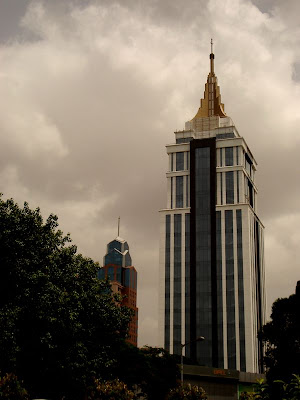 This will the third and last segment on birds for some time to come. After this I'll get back to showing off pictures of things that don't fly off or dive under water without a moment's notice, but stay squarely centered in viewfinders.
This will the third and last segment on birds for some time to come. After this I'll get back to showing off pictures of things that don't fly off or dive under water without a moment's notice, but stay squarely centered in viewfinders.#12 Spot-billed Duck: Anas poecilorhyncha.
Also known as the Spotbill, it's the one in the centre, behind the twigs. That's the best shot I got of the bird. It's being flanked on both sides by:
#13 Little Cormorant: Phalacrocorax niger.
Cormorants were the most common birds there, I think. It was the same with Ranganthittu 3 months ago. There are three species of cormorants found in large numbers in India, this one being the smallest and darkest.

#14 Indian Cormorant: Phalacrocorax fuscicollis
Slightly bigger, a little browner. They swim much lower in the water than ducks, giving them an almost Nessie-like appearance. This particular bird dived under water and did not resurface for at least 20 seconds, and it re-surfaced quite far from the place where it dove in.

 (I like my silhouettes. :))
(I like my silhouettes. :))
#15 Oriental Darter: Anhinga melanogaster.
The bird on the right, with the snake-like neck. Wasn't easy to identify, this.
Melanogaster means black-bellied, by the way. Drosophila (the fruit fly) and some species of buttonquail also shares the same name.

#16 Purple Swamphen: Porphyrio porphyrio poliocephalus.
Yes, a swamphen. Who knew such birds existed?
I can't get my head around why birds evolved such fancy colours. It's certainly not as a part of some fiendishly clever camouflage scheme (Purple in a swamp?). Yes, I know, colours and the display of fancy plumages is a big part of bird mating rituals, but surely there must be a more substantial evolutionary reason, like co-occurance with some other vital trait.


#17 Brahminy Kite: Haliastur indus.
The bird on the left. I remember them being very common in Delhi, and I've seen quite a few of them in Bangalore as well. Very distinctive white plumage on the head and neck, chestnut everywhere else. Usually identified with the Garuda of Indian mythology, the eagle vehicle of Vishnu.
#18 Black Kite: Milvus migrans.
At least, I think it's a black kite, cannot be sure. Too many birds which are similar in appearance. Could be a Lesser spotted eagle, a Steppe eagle, or a Common buzzard. The last of them is the most likely alternative. Eagles are bigger and half well-built feet unlike kites and buzzards, but it's difficult to check both size and the nature of the feet from this photograph.

There. 18 birds seen in some three hours. Not bad, eh? There would've easily been double the number of species there, if not more. With this being off-season. One little lake supporting this many birds. Hard to believe.
Pictures 5 and 6 courtesy Arun Verghese.
Also see:
A Little Bit of Ornithology: Part 1
A Little Bit of Ornithology: Part 2
And the road becomes my bride.
Shine on you crazy diamond.

































